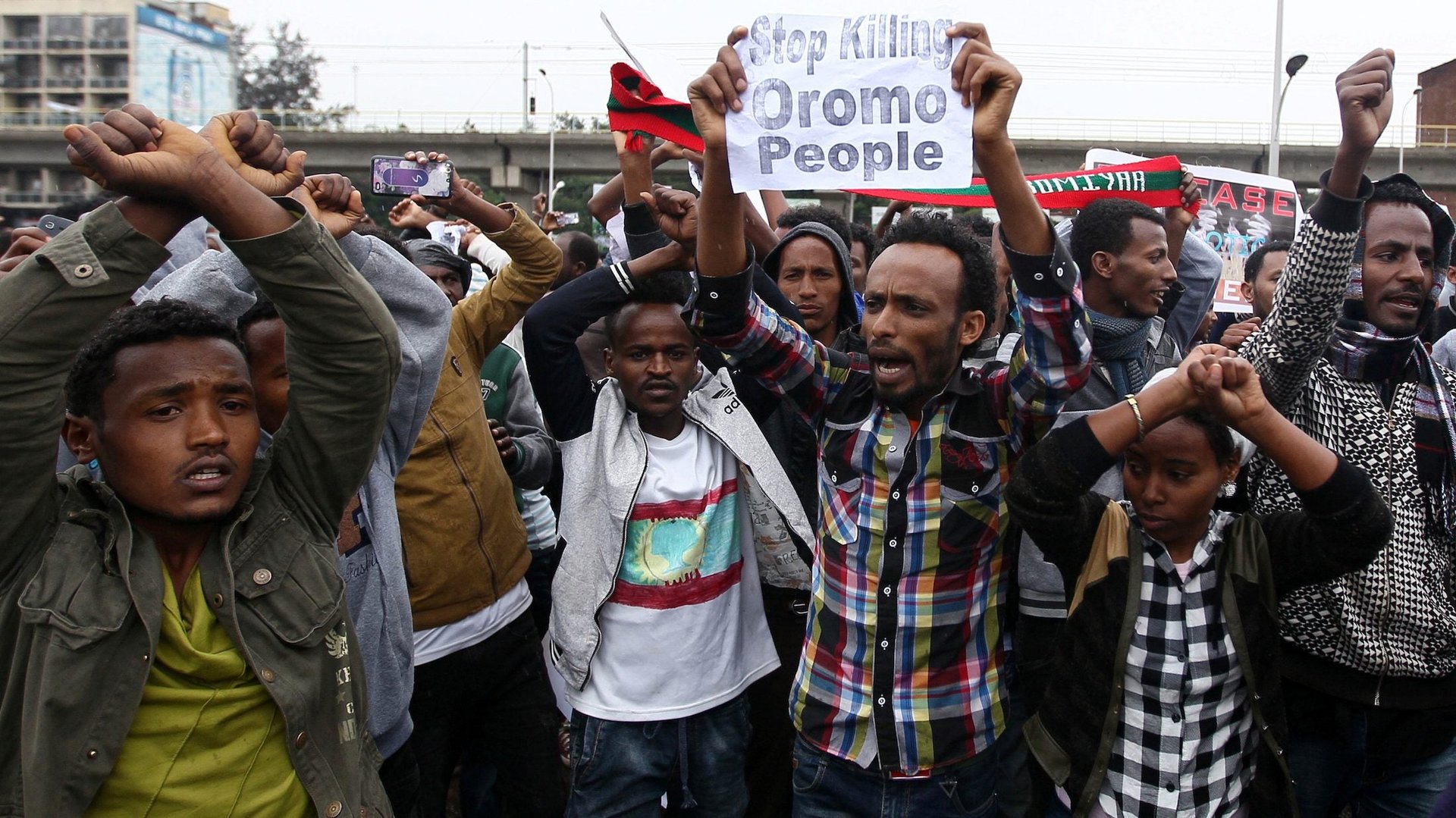Ethiopia’s previously divided ethnic groups are unifying to protest against the government
Ethiopia has experienced significant economic growth over the last 25 years, in part by embracing an authoritarian development model. But dissatisfaction with the government’s heavy-handed approach has mounted in recent months, culminating this weekend with thousands of demonstrators from two ethnic groups taking to the streets for the first time together to demand land reform, full political participation, and an end to human rights abuses in the country.


Ethiopia has experienced significant economic growth over the last 25 years, in part by embracing an authoritarian development model. But dissatisfaction with the government’s heavy-handed approach has mounted in recent months, culminating this weekend with thousands of demonstrators from two ethnic groups taking to the streets for the first time together to demand land reform, full political participation, and an end to human rights abuses in the country.
The demonstrations initially began in November last year in response to the government’s “Addis Ababa Integrated Master Plan,” which sought to expand the capital, currently home to more than 4.6 million people, into neighboring towns and villages inhabited by the Oromo, the country’s largest ethnic group. The Oromo said the plan would displace farmers and stymie the growth of their culture and identity.
The Ethiopian government reacted with brutal force. Human Rights Watch estimates around 400 protesters were killed, many of them students under 18 (the government disputes that number). Thousands were arrested, and Oromo community and government leaders were charged under the country’s harsh counterterrorism laws. Many have since gone on hunger strike to protest the conditions they are facing in prison. Despite this crackdown, the government bowed to pressure created by the protests, canceling the project in January.
Inspired by this mobilization, the country’s second most populous ethnic group, the Amhara, also began protesting against the government on land-related issues in July. The Oromo and the Amhara have a contentious history, but both feel they are politically and economically marginalized, despite making up more than 61% of the country’s population. And over the last few weeks, activists from both groups have expressed solidarity with each other’s protests, in the hopes that together, they can apply pressure on the government to reform.
In response, the Ethiopian government on Friday banned any types of demonstrations and blocked social media. People came out to protest anyway, and at least 97 people from both groups were believed killed by Ethiopian security forces, Amnesty International reported.
“I think we are reaching a tipping point,” says Mohammed Ademo, a Washington DC-based freelance journalist and founder of OPride.com, a website about Ethiopia, and the Oromia region in particular. “In my entire life, as a one-time protestor and organizer myself, I have never seen demonstrations taking place across the country in one day.”
Ethiopia’s government is dominated by the ethnic Tigray, who make up six percent of Ethiopia’s population of 99 million people. The ruling Ethiopian People’s Revolutionary Democratic Front (EPRDF) has been in power for 25 years, and the country’s parliament has no single opposition member.
Ethiopia was the fastest growing economy in the world in 2015, with 8.7% in GDP growth, according to the International Monetary Fund. But, in order to drive this rapid growth, the country has prioritized economic progress over building democratic institutions.
This was particularly evident under the leadership of the former prime minister, Meles Zenawi. During his 17-year rule, Zenawi reduced the number of Ethiopians living in extreme poverty, accelerated manufacturing and oversaw the planning of large-scale industrial projects like the Grand Ethiopian Renaissance Dam. At the same time, the government clamped down on press freedom, and curtailed civil and political rights, according to US-based advocacy group Freedom House.
Current prime minister Haile Mariam Dessalegn on Friday called the demonstrations a threat to national security. Using the hash tag #OromoProtests, opposition members and supporters abroad took to Twitter and Facebook to showcase the size of the protests and decry the government’s response. Some inside the country managed to circumvent the social media ban using proxy servers, says Ademo, before the government completely shut down internet access. Graphic photos and videos were shared, some appearing to show police beating demonstrators.
This show of unity between the Oromo and Amhara is unprecedented since the EPRDF came into power in 1991. It’s likely the government’s response will only unify the groups further, Ademo believes. “The government’s insistence on dealing with the protests only through more crackdown and repression is only likely to exacerbate tensions and draw in other marginalized groups,” Ademo says. “Either way you look at it, these are extraordinary times for Ethiopia and the youth are saying ‘Nu Gaye, Baqa’—enough is enough.”
Ethiopia is a key US ally in the Horn of Africa, receiving hundreds of millions of dollars in aid every year. During a visit there last year, president Barack Obama was criticized for praising the country’s leadership and calling it “democratically elected,” even as human rights and opposition groups have described the country as effectively an authoritarian regime.
Opposition groups have also taken aim at mainstream media’s “Ethiopia Rising” narrative, which they say overlook ethnic discontents across the country. With the scale of recent protests, it’s unlikely they’ll be able to ignore them anymore.